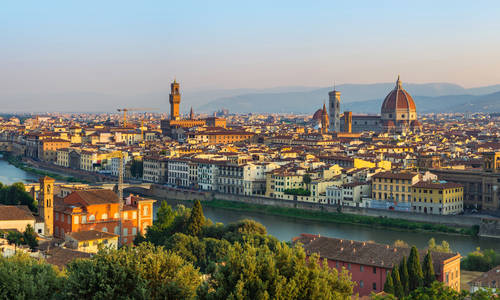Article content
7 January 2019 by Alice Somerset
Simply put, Tuscany’s capital is a world wonder. As the birthplace of the Renaissance, its medieval streets are lined with tiered bridges, a giant multi-coloured cathedral and world-class galleries that host masterpieces by such names as Michelangelo and Raphael. However, as it was once the cultural, economic and political centre of Europe, Florence is no secret. In fact, it has long been a tourism staple, with the city an important fixture on the Grand Tour – a rite of passage for the 18th-century elite. Here’s the insiders’ guide to avoiding the crowds that spill out onto its narrow streets.
When to go to Florence
The key to any good Florentine getaway is picking your moment. Avoid the height of the summer when temperatures can exceed 30°C and the Italian school holidays are in full swing. Instead, look either side for more temperate weather or even over winter to really avoid the crowds. There’s something particularly pretty about the pearly whites, accented reds and soft greens of the Duomo’s marble façade in the crisp, end-of-year sun.

Evening light hits the Ponte Vecchio and the River Arno in Florence
Don't miss the Galleria degli Uffizi
No trip to Florence would be complete without a visit to its premier gallery. Here you’ll find living marble sculptures, priceless oils from Renaissance masters and whole legends played out over dramatically frescoed ceilings. Get a taste with this interactive walk from Google. But, you won’t want a virtual experience of the queues – lines can last for hours. To avoid this, book ahead either over the phone, online or by speaking to your Wexas consultant. You’ll get a dedicated timeslot so you can skip the wait.
How to get around Florence
Don’t drive. With impossibly narrow streets, fiendish one way systems and instant fines of almost €100 for daring to set one unlicensed tire in the historic centre, it’s always easier to leave the car behind. Instead, you’ll find Florence to be entirely walkable, with a half hour’s stroll bringing you the breadth of the city. In fact, it’s the best way of getting to know old Firenze as twistingly atmospheric laneways lead you between medieval sites, discovering a welcoming trattoria or lesser-known architectural wonder around every corner. To get in and out, you’ll find the train station to be perfectly central while a short taxi or bus ride will see you to the airport.
Make sure to turn south
As with our London, Florence’s historic sprawl is centred on the northern banks of its river. As such, its southern half offers the chance to escape for some leafy respite. While the formal Boboli Gardens and their fountains, blooming flowerbeds and stunning sculptures impress, a simple walk from the Piazzale Michelangelo to the Porta Romana is a quiet delight and my favourite route in Florence. Entirely shaded by century-old oaks and those famously Tuscan cypress trees, it’s a two-mile stroll that passes medieval basilicas and the mansions of the city’s cultural elite. Along the way, you’ll glimpse giant vistas over Florence’s terracotta-roofed beauty in between the dense verdure. If all this sounds appealing, perhaps splurge on a stay at Villa Cora – a 19th-century aristocratic palace complete with ballroom.

The lavish interior of Villa Cora
Get off the beaten track
With such a wealth of attractions, Florence has many sites that would be centrepieces in any other city. As mentioned previously, the best way to get to know it is by foot, losing yourself in its labyrinthine medieval streets. You’ll quickly find yourself stumbling across hidden gems, whether it’s an alleyway of violin makers, centuries-old churches or simply the chance to watch the world go by from a quiet, plaza-side café. My lesser-visited favourites are the Santa Maria Novella – a 14th-century basilica adorned with fantastically coloured frescoes – and the Forte di Belvedere, an imposing 400-year-old fortress hidden among the city’s southern hills.
Experience sunset at Piazzale de Michelangelo
In somewhat of a contradiction to the last tip, an undiscovered gem this is not. However, the Piazzale de Michelangelo offers the best views of Florence, given that – unlike the central towers – it’s set back from the city. As such, the square looks out, over the River Arno, to Florence’s orange-roof skyline, defined by the Duomo’s great dome and the Arnolfo Tower’s imposing brickwork. Be sure to arrive in time for sunset when the city’s delightful architecture erupts in multi-coloured hue. What’s more, it’s free and just a 20 minute-or-so walk from the centre.
Liked this? Read our cultural guide to Italy and our guide to Italian wine for more on Italy.




